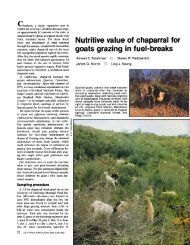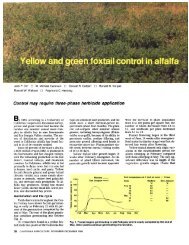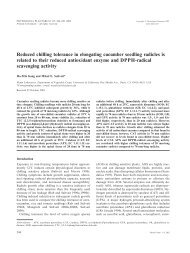PROPAGATION of Apple Rootstocks by Hardwood Cuttings - UCCE ...
PROPAGATION of Apple Rootstocks by Hardwood Cuttings - UCCE ...
PROPAGATION of Apple Rootstocks by Hardwood Cuttings - UCCE ...
You also want an ePaper? Increase the reach of your titles
YUMPU automatically turns print PDFs into web optimized ePapers that Google loves.
cultural equipment for nontillage was<br />
$20,025, as compared with $23,350 for<br />
the tillage system.<br />
A detailed cost analysis for the non-<br />
tillage system is shown in the table. The<br />
total cost per acre under nontillage was<br />
$496.69, as compared with $517.28 per<br />
acre for the conventional tillage method.<br />
This meant a saving <strong>of</strong> $20.46 per acre,<br />
or per ton, in this case. The savings were<br />
possible mainly through the substitution<br />
<strong>of</strong> mowing and weed spraying for the<br />
usual methods <strong>of</strong> soil management. Addi-<br />
tional savings resulted from the elimina-<br />
tion <strong>of</strong> a soil-sealing irrigation prior to<br />
harvest and through lower overhead costs<br />
for equipment.<br />
Tillage costs<br />
Specific deviations for the tillage sys-<br />
tem, as compared with the nontillage<br />
method shown in the table include elimi-<br />
nation <strong>of</strong> the five starred items in the<br />
first part and substitution <strong>of</strong> two items:<br />
(1) Cultivate 16X, figured at 5 hours per<br />
acre with labor costs <strong>of</strong> $11 and fuel and<br />
repair costs at $6 for a total cost <strong>of</strong> $17<br />
per acre; and (2) hoe around trees,<br />
figured at 1.7 hours per acre with labor<br />
costs <strong>of</strong> $3 per acre.<br />
Three irrigations were used under the<br />
nontillage system for a total <strong>of</strong> $16.20<br />
per acre, as compared with four irriga-<br />
tions (including the soil-sealing irriga-<br />
tion) under a tillage program for a total<br />
<strong>of</strong> $20.10 per acre.<br />
Total hours and cultural cost figures<br />
lor tillage were $191.12, compared with<br />
$176.83 per acre for the nontillage sys-<br />
tem. Miscellaneous overhead expenses<br />
were figured at $10.98 for tillage as com-<br />
pared with $10.27 shown in the table for<br />
nontillage. These changes brought the<br />
total cash costs for tillage to $257.60 in-<br />
stead <strong>of</strong> $242.60 as shown in the table for<br />
nontillage. Per acre costs for cultural<br />
equipment (under investment) were $292<br />
per acre for tillage with depreciation<br />
figured at $29.20 and interest at $8.76<br />
for a total investment cost <strong>of</strong> $229.55, as<br />
compared with $224.09 for nontillage.<br />
Total costs per acre (including invest-<br />
ment) were $51728 for tillage, as com-<br />
pared with $496.69 for nontillage. Costs<br />
per pound <strong>of</strong> almonds produced (figuring<br />
a 2000 lb per acre yield) came to 25.9<br />
cents for tillage, as compared with 24.8<br />
cents for nontillage.<br />
Clem Meith is Farm Advisor, Butte<br />
County; and Phil Parsons is Extension<br />
Economist, University <strong>of</strong> California,<br />
Davis.<br />
4<br />
<strong>PROPAGATION</strong> <strong>of</strong><br />
<strong>Apple</strong> <strong>Rootstocks</strong> <strong>by</strong><br />
<strong>Hardwood</strong>i<strong>Cuttings</strong><br />
H. T. HARTMANN C. J. HANSEN F. LORETI<br />
Excellent nursery trees <strong>of</strong> several clonal apple rootstocks were produced in these<br />
tests 11 months after hardwood cuttings were planted. Preplanting treatments<br />
with indolebutyric acid followed <strong>by</strong> bottom heat at the base <strong>of</strong> the cuttings, while<br />
the tops were exposed to normal winter chilling, were necessary. This method<br />
could replace the more expensive and slower “stooling” method <strong>of</strong> propagating<br />
clonal apple rootstocks.<br />
N MANY APPLE-growing regions <strong>of</strong> the<br />
I world, clonal, self-rooted rootstocks<br />
are used to propagate new trees rather<br />
than apple seedlings. Such clonal stocks<br />
are largely the East Malling and Malling-<br />
Merton size-controlling stocks selected<br />
and developed at the East Malling Research<br />
Station and the John Innes Horticultural<br />
Institution, both in England. In<br />
the past, these rootstocks have usually<br />
been propagated <strong>by</strong> the “stooling” or<br />
mound-layering method in which soil is<br />
mounded up around the young shoots<br />
arising from the base <strong>of</strong> the mother plant.<br />
These shoots form roots during the grow-<br />
ing season and after they become dor-<br />
mant are cut <strong>of</strong>f to be lined out in the<br />
nursery for another season’s growth. This<br />
method is slow, cumbersome, and expen-<br />
sive. On the other hand, propagation <strong>by</strong><br />
hardwood cuttings is fast and inexpen-<br />
sive.<br />
In the trials reported here, studies were<br />
made <strong>of</strong> the propagation <strong>of</strong> several apple<br />
rootstocks <strong>by</strong> the use <strong>of</strong> hardwood cut-<br />
tings. Cutting material obtained from<br />
Oregon was made into hardwood cuttings<br />
on January 2, 19M. The cuttings were<br />
Photo 1. Root system <strong>of</strong> Malling-Merton 11 1 apple rootstock 12 months after starting from hard-<br />
wood cuttings. Length <strong>of</strong> rule is 18 inches.<br />
CALIFORNIA AGRICULTURE, JUNE, 1965
made from one-year-old wood sawed to<br />
a length <strong>of</strong> 8 inches <strong>by</strong> a band saw. Prior<br />
to further treatment, the bases <strong>of</strong> the<br />
cuttings were soaked in an indolebutyric<br />
acid solution in water at 100 ppm (parts<br />
per million) for 24 hours. Three methods<br />
<strong>of</strong> handling were subsequently used for<br />
each clone: (1) planting directly in the<br />
nursery row, (2) storing the cuttings in<br />
damp peat moss at 70 degrees F (21 de-<br />
grees C) for about three weeks before<br />
planting, and (3) placing the cuttings<br />
over bottom heat at 70 degrees F in a<br />
covered outdoor bed, where the top buds<br />
would be chilled, for about three weeks<br />
before planting.<br />
Cutting treatments<br />
<strong>Cuttings</strong> given the first treatment were<br />
planted in the nursery on January 3,<br />
while those receiving the second and<br />
third treatments were planted January<br />
27. In treatment 1 the cuttings were in-<br />
serted <strong>by</strong> pushing them into loose, pre-<br />
viously rototilled soil to a depth <strong>of</strong> about<br />
7 inches. In treatments 2 and 3, where a<br />
heavy callus and-in some instances-<br />
short roots had developed at the base <strong>of</strong><br />
the cuttings <strong>by</strong> the time <strong>of</strong> planting, the<br />
cuttings were carefully placed in a trench<br />
and covered with soil to a depth <strong>of</strong> 7<br />
inches. Soil temperature at the base <strong>of</strong><br />
the cuttings was about 45 degrees F (7<br />
degrees C) in January at Davis, Cali-<br />
fornia.<br />
The table lists the clonal rootstocks<br />
given these treatments and shows the<br />
rooting results obtained. Approximately<br />
90 cuttings were used for each individual<br />
treatment, divided into three replicates,<br />
each planted in different areas in the<br />
nursery. Best rooting was obtained with<br />
E.M. IX, E.M. VII, E.M. 26, and M.M.<br />
111 <strong>by</strong> the third method <strong>of</strong> handling the<br />
cuttings-IBA treatments followed <strong>by</strong> a<br />
callusing period over bottom heat while<br />
the top buds were chilled. Very little<br />
rooting <strong>of</strong> hardwood cuttings <strong>of</strong> M.M.<br />
104 was obtained <strong>by</strong> any <strong>of</strong> the treat-<br />
ments. The results obtained with M.M.<br />
106 were somewhat erratic; while the<br />
highest rooting with this clone occurred<br />
with treatment 3, it was not significantly<br />
superior to the other two. Generally very<br />
poor rooting was obtained with cuttings<br />
<strong>of</strong> any <strong>of</strong> the clones when they were<br />
planted directly in the nursery row<br />
(treatment 1).<br />
Excellent nursery trees were produced<br />
eleven months after the cuttings were<br />
made. Photo 3 shows the appearance <strong>of</strong><br />
trees <strong>of</strong> M.M. 111 in November, 1964.<br />
Photo 1 shows the root system developed<br />
<strong>by</strong> December, 19a. Photo 2 shows the<br />
CALIFORNIA AGRICULTURE, JUNE, 1965<br />
Photo 2. Root system <strong>of</strong><br />
East Malling IX apple root-<br />
stock 12 months after start-<br />
ing from hardwood cut-<br />
tings. length <strong>of</strong> rule is 18<br />
inches.<br />
root system produced <strong>by</strong> the hardwood<br />
cuttings <strong>of</strong> E.M. IX.<br />
Commercially, these nursery rootstock<br />
trees would be large enough for fall<br />
budding to the desired top variety <strong>by</strong> late<br />
July or August. They would then be<br />
grown in the nursery for an additional<br />
season to produce the complete nursery<br />
tree, composed <strong>of</strong> the varietal top and the<br />
clonal rootstock.<br />
H. T. Hartmann and C. J. Hartsen are<br />
Pr<strong>of</strong>essors, Department <strong>of</strong> Pomology,<br />
University <strong>of</strong> California, Davis. F. Loreti<br />
is Assistant Pr<strong>of</strong>essor, lnstituto di Colti-<br />
vazwni Arboree, University <strong>of</strong> Pisa, Pisa,<br />
Italy.<br />
<strong>PROPAGATION</strong> OF CLONAL APPLE ROOTSTOCKS BY<br />
HARDWOOD CUTTINGS<br />
THE CUTTINGS, MADE JANUARY 2, 1964. WERE<br />
TREATED WITH INDOLEBUTYRIC ACID AT 100 PPM<br />
FOR 24 HOURS. NINETY CUlllNGS PER TREATMENT.<br />
Clone<br />
Difference<br />
required for<br />
Significance:<br />
Per cent <strong>of</strong> cuttings rooted<br />
5% 1%<br />
Treat. 1' Treat. 2t Treat. 3% level level<br />
E.M. IX 0.0 1.0 19.7 5.5 8.2<br />
E.M. VII 0.0 0.0 29.1 8.6 13.1<br />
E.M. 26 16.6 43.9 63.6 7.8 11.9<br />
M.M. 104 0.0 0.0 1.1 1.2 1.8<br />
M.M. 106 17.1 3.4 20.7 25.6 38.8<br />
M.M. 111 2.1 12.9 60.9 10.8 16.4<br />
Difference required for significance:<br />
at 5% level 4.1 5.1 9.9<br />
at 1% level 5.6 7.0 13.6<br />
Planted directly in the nursery.<br />
t Held in damp peot moss at 700 F until roots ap<br />
peared, then planhd.<br />
$ Held over bottom heat at 70" F outdoors until roots<br />
appeared, then planted.<br />
Photo 3. Nursery trees <strong>of</strong> Malling-Merton 111 apple rootstock 11 months after starting from<br />
hardwood cuttings. Height <strong>of</strong> screen is 5 ft.<br />
5
















